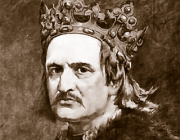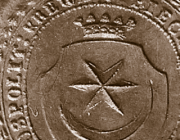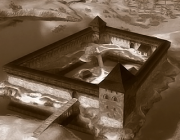Kreva on the pages of chronicles
Love drama, uncle's murder and union with Poland
XIII – XVI
Although the settlement at the source of the river Krevlianka appeared much earlier, the pages of chronicles mentioned Kreva only in the 14th century. Witnesses to this are an ancient fortification, which has survived till our days and the mounds found in the XIX century close to them.
What happened in Kreva before it appears in chronicles?
Historians are still arguing about this. There is a version that Kreva was the capital of the Nalshanskoe Principality.
Nalshany in the XIII century were known as “Lithuanian lands”. They were owned by duke Dovmont. In 1258 Mongolian Tatars under the leadership of Khan Burundai and the army of the Volynian duke Vasilko Romanovich attacked the principality. And in 1263 a real love drama took place here. Duke Dovmont killed the founder of the Grand Duchy of Lithuania Mindovg. The king took death because of the woman – Princess of Nalshany. Mindovg took his wife away from Dovmont and Dovmont took his revenge upon him.
A year later Nalshany was conquered by Wojselk, son of Mindovg. Dovmont fled to Pskov, and there he was elected to reign. After that Nalshany became a member of the Grand Duchy of Lithuania and began to obey Gerden, the duke of Polotsk.
This romantic story formed the basis of many books. In these books Kreva is named as the capital of Nalshany, but It is unknown, if that was the reality. Some historians believe that the Principality of Nalshany was located in a completely different place, not near Kreva, but on the territory of modern Lithuania or even Latvia.
Another controversial issue in the history of Kreva: who were the first inhabitants of these places – Balts or Slavic-Krivichi? And how did the name of the settlement appear? Historians still do not have a common opinion. Some of them believe that Kreva came from the word “krivichi”. Others – on behalf of the Lithuanian supreme pagan priest Kreva-Kreveite.
The walls of the castle have seen Vitovt wearing woman dress
At the end of the 13th – early 14th centuries crusaders of the Teutonic Order began to appear in our lands more often. The old fortifications, made from wood and soil, couldn’t hold back attacks of one of the best armies in Europe. On the western border of the Grand Duchy of Lithuania they began to build solid stone castles, and Kreva Castle is one of them. They say, it was laid by the Grand Duke Gedimin and his son Olgerd continued the construction. And in the second half of the 14th century the castle became the center of important historical events.
In 1338, Gedimin divided the inheritance and handed over Kreva to Olgerd. In this connection the settlement was first mentioned in the annals. In 1345, Olgerd took the Great Throne of Duchy in Vilna and Kreva passed into the possession of his son Jagailo. Being on the throne, Olgerd always relied on help of his brother Keistut. A dual power was established in the state.
After Olgerd has died, Jagailo became the Grand Duke of Lithuania. Keistut was disagree with his nephew’s politics, so he started to claim the throne. A struggle began between them. Keistut with the army captured Vilna. He proclaimed himself the ruler of the Duchy. He convicted Jagailo in collaboration with Crusaders and exiled him to Kreva. However Jagailo did not submit his fate. Jagailo enlisted the support of the Crusaders and seized Keistut in Troki near Vilna. Uncle was forced to the peace negotiations.
Jagailo promised to start negotiations, but eventually captured Keistut and his son Vitovt. He ordered to bring Keistut to Kreva and thrown him into the castle prison. Vitovt was accompanied with guards to Vilna in custody. So Jagailo became the sovereign ruler of the Grand Duchy of Lithuania again. Keistut held four days in the cave of Kreva Castle. On the fifth day of his imprisonment Jagailo servants came into the prison cell of the old prince and strangled him with a lace from his clothes.
Perhaps the same end was prepared for Vitovt. He also was brought to Kreva and placed in one of the castle cells. But Vitovt managed to escape in an unusual way. The wife of Vitovt, Anna, was allowed to visit the prisoner. One evening she came to husband came with her maid. Vitovt changed into a maid’s dress and left his cell so the guards did not notice the substitution.
How Kreva became famous in Europe
A landmark event for the town was the conclusion of the Kreva Union. It was a dynastic alliance between the Grand Duchy of Lithuania and the Kingdom of Poland. The act was signed on 14th of August 1385. According to this document, Grand Duke Jagailo married Polish Queen and became the King of Poland. At the same time Jagailo gave a number of promises. For example, he was converted to Catholicism and promised to baptise all the pagans of Lithuania according to the Catholic rite.
That was a beneficial alliance for both states. It allowed to unite forces against the Crusaders. The result of the Kreva Unia was the victory at the Battle of Grunwald in 1410. Simultaneously the Unia caused many disputes and conflicts. Jagailo fulfilled the conditions of the Kreva Union. He built seven Catholic churches in the Grand Duchy of Lithuania. Among them is the church of St. John the Baptist in Kreva.
Who destroyed the ancient castle in Kreva?
At the end of the 14th century the lands of Kreva passed to the Grand Duchy of Lithuania. Kreva became the center of old district. Kreva Castle remained an important strategic fortification for a long time. It was attacked and destroyed quite often. The first significant wounds were inflicted in 1433 during the uprising. It was initiated by Jagailo’s brother, Svidrigailo, who was unsatisfied with the politics of Jagailo. “And coming to Kreva, and standing for two days, taking Kreva and demolished and burnt, and people killed and captured” – this is how this event was described in the Suprasl Chronicle.
In 1503-1506 the Kreva Castle suffered from raids of Crimean Tatars. And in August 1519 Kreva was hit by the Russian-Lithuanian war. Through the territory of the region on the way to Vilna led their troops Russian military commanders Shuiski, Gorbun and Kurbski. There was a large Lithuanian army based by Kreva, but it has to leave the place and move to impassable labdscapes behind Losk. The conquerors devastated and plundered the castle. Although the German diplomat Sigismund Gerberstein testified that already a year before these events nobody lived in the castle. In his “Notes on Moskovia” he wrote: “Crevua oppidum cum castro deserto” (“City of Kreva with an empty castle”). It might be that the castle was used only for military needs as a battle fortress on those time.







